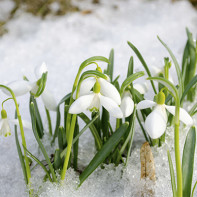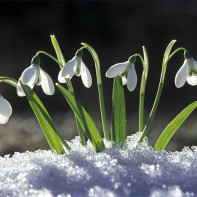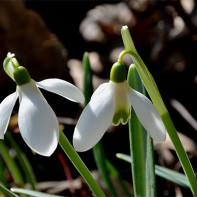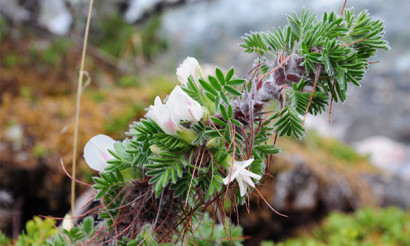Snowdrop: medicinal properties and contraindications
As a beautiful legend says, God drove Adam and Eve out of paradise in winter. Eve endured the cold and snow hard, and observing her suffering, nature decided to cheer up the girl and turned some of the delicate snowflakes into equally delicate delicate delicate flowers. Since that time, at the end of winter or very early spring, the earth has been covered with pleasantly smelling delicate exquisite snowdrops.
- Chemical composition
- What it looks like and where it grows
- Types
- Gathering and storage
- Therapeutic properties of Snowdrop
- Snowdrop in traditional medicine
- For boils and scabies.
- For joint pains.
- For improving adrenal gland function
- For fungus
- For joint pain
- For cystitis and pyelonephritis
- Ointment for sore joints
- For skin problems
- For acute joint pain
- For toothache
- From arthritis
- Types of medicinal compositions
- Infusion
- Tincture
- Decoction
- Contraindications for use
Snowdrop is a typical primrose. It blossoms during the snow melting and because this period differs in some regions it can blossom with elegant miniature inflorescences from the last week of February to the middle of April, depending on the climatic zone where it grows.
The scientific name of the snowdrop is galanthus, derived from two Greek roots, gaala and apthos, which means "milk flower".
Chemical composition
With this beautiful delicate flower you need to be on the lookout: the thing is that each part of it contains a whole group of alkaloids consisting of 37 substances - these are nivalin, lycorin, galanthine, tazettin, and also the most sought after galanthamine. Its greatest concentration is concentrated in the bulb. Galantamine has the ability to affect the central nervous system by stimulating the activity of the cells of the brain and spinal cord, for which this plant is used in official medicine.
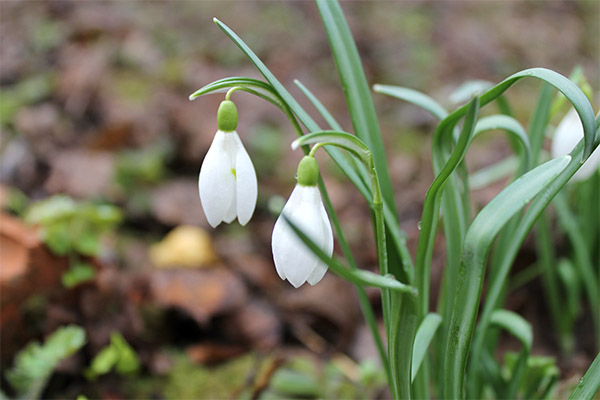
Nivalin has also long been used for medicinal purposes. In particular, Tibetan monks used it to relieve leg spasms and treat cancer, which, however, was not used in official medicine.
Looking at the overall distribution of alkaloids in the plant, it should be noted that tasettin predominates in the bulbs and lycorin in the leaves.
The next component of the snowdrop is tannins. Their distinctive feature is the ability to detoxify carcinogens, free the intestines from toxins and protect the gastrointestinal tract from inflammation, stop blood flow.
Organic acids, also an ingredient of this medicinal plant, support the immune system and acid-alkaline balance of the human body, improve intestinal function and stimulate the synthesis of gastric juice.
Various parts of the snowdrop also contain mineral compounds, sugars, lipids and vitamins, but their properties are not used in practice.
What it looks like and where it grows
Sunflower botanists refer to the perennial bulbous plants. Its growing season is short - only a few weeks. At first it pleases with delicate flowers, in two weeks they die off, and following them in speed the leaves also fade.
The bulb has a small bulb - 2 to 3 cm. It is formed from the scales of last year and the year before, and it also has a bud of regeneration. Scales are formed every year - three per season. In their axils the baby bulbs hide.
Every spring, long linear leaves emerge from the bulbs in a friendly bunch. At the same time the buds appear. Their flower stalks grow higher than the leaves, which seem to recede into the background, letting the world admire the first beautiful flowers. However, after the flowering, the leaves begin to grow actively and may reach a length of 20 centimeters and a width of up to 3 centimeters. The tops of the leaves of various Snowdrop species are either pointed or rounded.
The leaf color can be either light green, even with some yellowish cast, or a dense green. Leaf blades look dull and shiny, as if covered with a coating of grease or wax. Some species are characterized by a smooth leaf, others by a creased leaf.
The pedicel is shaped like a tube and is usually shiny. The bract consists of three white outer leaflets, rather long, up to 3 cm, and three inner ones.
The stamens sit deep inside the flower. The plant is pollinated by the first early insects - bees, flies, butterflies. And in May the fruit ripens - it's quite fleshy juicy box, inside which, behind the flaps, hides round seeds.
Snowdrop grows throughout Europe, except for the harsh northern regions, as well as in regions of Asia Minor. Especially many varieties of the plant are found in the Caucasus. It is the Caucasian foothills that are considered the birthplace of the snowdrop and from there it has spread to other areas.
Species
Snowdrop has 19 varieties, with most of them - 12 - growing in Russia and neighboring countries.
Voronov's Snowdrop was named after the great plant expert of the Caucasus botanist Y. N. Voronov. This particular variety of plant is cultivated and used for medicinal purposes. It is characterized by bright green, shiny leaves that have a slightly yellowish cast. The leaves are slightly "folded" in half lengthwise, so there is a so-called keel on the underside. At the end of flowering, the leaves grow to 22 cm, bend away from the middle, where the flower stalk is located, and curl toward the slant.
The flower stalk grows to 15 cm in height, holding a flower about 4.5 cm long. The flowering period of Voronov's cauliflower is February or early March. The fruits ripen in May and already in June the plant dies off.
This species is found only in the Caucasus. Its range runs along the eastern coast of the Black Sea and slightly overtakes Turkey. It does not move far from the border between water and land, but closer to the south it can ascend into the mountains, located about 40 km from the coast. Its element is the broadleaf rainforests.
Snowflower Snowflower is characterized by blue leaves, as if covered with a coating of wax, at the end of flowering they stretch to 25 cm. At the end of the white petals there is a green spot in the shape of a horseshoe.
As its area of distribution is quite wide - from Central and Eastern Europe to Transcaucasia, the flowering time also stretches as it moves from the south to more northern regions - from January to April.
Under natural conditions it is admired by inhabitants of many European countries - from Germany, which is the northernmost country where the snowdrop grows, to Italy, including Sicily. The southernmost latitudes, where this plant is not rare, is Turkey. In Russia it is not difficult to find it in the regions of the southern reaches of the Don.
Snowflower can be seen on forest edges or in brushwood as well as in free open spaces - from the foothills to the alpine mountain belt. This plant is the earliest melliferous plant in nature, from which bees harvest nectar as early as February.
The narrow-leaved snowdrop is very similar to its cousin, the white snowdrop, but is more miniature. It is found only in Kabardino-Balkaria, where it grows among bushes on the northern slopes of the mountains at a considerable height of up to 700 m above sea level. Because of its mass collection for bouquets the plant is threatened with extinction, and is therefore included in the Red Book of Russia.
The Elvis snowdrop is named after English botanist Henry John Elvis. He was the first to find and describe this plant species in 1874. Its leaves can be either green or blue, with a small clobber on their tops. The flowers are small, with petals up to 2 cm long, with a green spot on their base and apex. Widespread in Bulgaria, in the eastern territories of former Yugoslavia, in all but the eastern regions of Turkey and on islands in the Aegean Sea. Widely used in garden ornamental floriculture.
Snowdrop Flat-leaved is found only in mountain meadows and gorge slopes in North Ossetia and Georgia, it grows nowhere else in the world. Its bulb is one of the largest of all snowdrops - up to 5 cm long and about 4 cm in diameter, with white scales. The glossy leaves are thick dark green, flat and broad, with a distinct petiole. They grow to 25 cm after flowering, more than 3.5 cm wide. The flower stems continue to grow after flowering, reaching a length of up to 22 cm, though they usually don't exceed 15 cm. The flowering period of Snowdrop Flatulent is April and May.
Crested Snowdrop is characterized by its cartilaginous folded blunt bluish-green leaves. They seem to be covered with a waxy plaque, and after blooming, they become greasy. The peduncle also looks like it is covered with wax, and the flowers are large, with petals up to 5 cm. At first they are considerably longer than the pedicel, but it continues to grow during the flowering period and eventually gains the desired length.
Snowdrop blooms in March and April and has a deep and bright scent. Its area of distribution is the mountains and foothills of Moldova, Crimea and Romania, where it grows on forest edges and in thickets of bushes. This variety of the plant is so beloved by florists that they derived from it 10 varieties of decorative snowdrop, which are well accustomed to Russian gardens.
Snowdrop Queen Olga have a very small oval bulb - no more than 2 cm long and 1.5 cm in diameter. This type of snowdrop is distinguished by the fact that its leaves do not show in the spring, but in autumn, far after flowering, in September and October. The flowers are medium-sized, with petals up to 2.5 cm long. This snowdrop grows on the edges of fir and spruce forests in southern Greece.
Harvesting and storage
The most valuable from a medicinal point of view is considered to be the bulb of the snowdrop, it is collected in April or May. But since the snowdrop is considered an endangered plant and many of its varieties are listed in the federal and regional Red Data Books, it is better to collect its above-ground parts - the flowers and leaves. They also have many medicinal properties.
It is important not to make a mistake and take the plant only if you are absolutely sure that it is a snowdrop. The right thing to do is to go to the places where snowdrop grows en masse, quite densely and densely.
Before going for a medicinal plant must be equipped with gloves, in which to collect the raw material, so as not to be poisoned by potent substances contained in the bulbs, leaves and flowers.
The weather for harvesting should be sunny, warm and clear. It is better to begin work before dinner, when the dew has already disappeared.
The specific date of collection of medicinal raw materials should be determined by the stage at which the flower is blossoming. It is best not to delay and start collecting when the buds have just blossomed. In no case should you wait until the flowering is almost over and the seed capsules have begun to set.
Do not collect every plant in a row, otherwise the snowdrop population will never recover. After digging the bulbs carefully shake off the soil, cut off the roots with a secateurs, wash the raw material and use fresh. From the bulbs can be made juice or water and alcohol infusions.
The green part of the plants should also be cut during the flowering period, spread out on paper or cotton cloth on a well-ventilated veranda or just under a canopy to keep out the rain. After drying, grind into a powder, on the basis of which then prepare decoctions and aqueous tinctures. Store in a well corked glass container for a year.
Before preparing medicinal compositions from raw materials, you need to make sure that the herb is not spoiled. After opening a container where the powder is stored, you need to smell it. There should be no extraneous odors - only the aroma of the plant. On the appearance and color you should also pay attention and use only the raw material that has been preserved perfectly.
Medicinal properties of snowdrop
In the snowdrop of most medical interest is the alkaloid galantamine. It is the main component of the plant, on which the treatment methods are based.
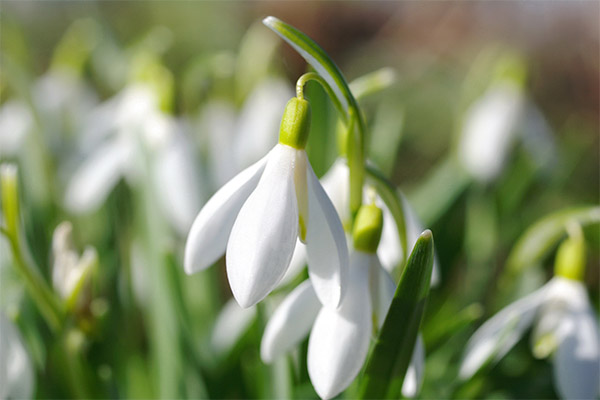
- Galantamine is considered an indispensable treatment for the symptoms of poliomyelitis and cerebral palsy. The alkaloid is also recognized effective for relieving suffering in sciatica, polyneuritis, myopathy, as well as for recovery of the body after serious injuries affecting the motor nerves, especially in the recovery process after traffic accidents. Its use is due to the ability of galantamine to restore the connection between the nervous and muscular systems, which plays an important role in improving the mobility of the arms and legs. And the effectiveness of snowdrop has been repeatedly confirmed by practice during the outbreak of polio, which occurred after World War II, when other means to combat this terrible disease was simply not available.
- The compositions based on snowdrop, and prepared from any of its parts - from the bulb to the flowers, help reduce the frequency of epileptic seizures, relieve seizures, calm the nerves, smooth the hysterical state, relieve insomnia and establish a healthy sound sleep.
- Because of galantamine's ability to lower blood pressure, it is used to treat the initial stages of hypertension. Heart disease is another area where this herb is used.
- Galantamine improves intestinal peristalsis and stimulates saliva production, so it can be used to help with digestion. In gynecology, the alkaloid of the snowdrop is also in demand: it helps relieve inflammation of the female genital organs, and also eliminates menstrual cycle problems, especially if they were associated with scarce and painful menstruation.
- The plant has good results as a remedy for skin problems such as fungal infestation or scabies, as this herb has antimycotic properties.
- With boils and pustules formulations on its basis also quite well cope, in the basis of their action is the antiseptic effect inherent in the alkaloid galantamine. To eliminate these problems externally are used decoctions and tinctures of snowdrop. Because of their antiseptic effect, they are also used internally - they are used as an additional means in the treatment of colds and bronchitis. With sore throat, you can gargle with preparations of this plant.
Snowdrop in folk medicine
Most often folk healers prescribe compositions of snowdrop externally, and usually it is alcohol or water tinctures on the bulbs or green parts of the plant. But there are in their healing arsenal and means for internal use.
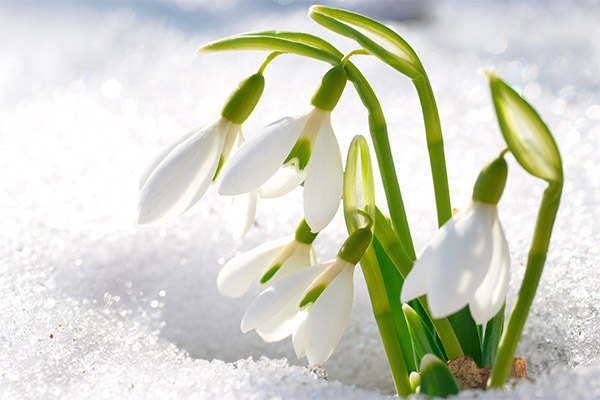
It is important not to forget after the external application of medicinal compositions based on snowdrop rinse with water the place of application and hands - so as not to have unpleasant symptoms of poisoning.
For boils and scabies
To prepare this tincture, you will need snowdrop bulbs. For 10 g of bulbs take 1 liter of undiluted medical alcohol. Chop the bulbs slightly with a knife (do it with gloves, to avoid poisoning) and pour the alcohol in a clean glass dish - for example, in a jar. Close the jar tightly and leave for a month insist in a dark cool place. When the tincture will be ready, strain it and store, be sure to make an indication on the jar that it is a poisonous remedy.
Such a composition is used to treat the skin for fungal infections, as well as in the case of its lesion of boils or scabies.
For joint pains
To prepare a tincture to relieve pain in large and small joints, sciatica, you can take 50 g bulbs or 100 g of leaves. Crush the medicinal raw materials and pour pure medical alcohol (one liter). Remove to a month in a dark, cold place to insist. Then filtered and used in the form of compresses. To avoid burning the skin, apply a compress not more than 15 minutes. You can simply rub the tincture over the sore spots.
To improve adrenal function
In order to normalize the activity of the adrenal glands, a tincture on the flowers is used. Collect them a lot - about 80 grams of flowers together with peduncles. Pour the fresh raw material in a glass or ceramic bowl with half a liter of quality vodka. Insist in a place where the container will not be exposed to sunlight for 40 days. Then strain the tincture and use 3 times a day before meals. Rate of intake at a time - no more than 20 drops. To improve the taste, you can combine taking the remedy with half a teaspoon of honey.
To treat fungus
Since ancient times, veduns have been using a water cold infusion of snowdrop to combat fungal skin diseases. For its preparation, just plucked leaves of the plant (three small bundles) to pour 3 liters of cold water and leave for 12 hours. After this time, the composition for the foot bath is ready. It is better to prepare it in the morning, to apply every evening - until the symptoms of fungal infection disappear. The duration of the procedure is up to 20-30 minutes. Before immersing your feet in the healing remedy, it should be heated to a comfortable temperature.
For joint pain
Decoction of the leaves and flowers of the plant is effective for pain in the joints - both large and small. For its preparation, you need the above-ground parts of the plant - leaves and flowers. A good bundle of the plant is boiled for a quarter of an hour in half a liter of water. When it cools to a warm state, strain, soak gauze or cotton cloth in the healing composition and apply as a compress to the problem areas. Keep such a compress should not last longer than 15 minutes - it may burn. Carry out the procedure better before going to bed, then immediately wrap the painful joint with a warm shawl or scarf for the night.
For cystitis and pyelonephritis
Snowdrop is used by folk healers to treat inflammation of the organs of the excretory system - kidney and bladder - such as cystitis or pyelonephritis. This composition will also help to get rid of bedwetting or frequent and uncontrolled urination. To make it, you need a powder of dried leaves and flowers of the plant. Pour 300 ml of boiling water with 10 grams of healing powder and send the composition to a water bath, where it is heated for 20 minutes. Remove, cool and strain. Drink 5 g (or teaspoon) 3 times a day. You should drink plenty of fluids at the same time as taking this remedy. The result will be the successful removal of infection from the kidneys and bladder.
Ointment for joint pain
Observing all precautions, grind on a grater or with a blender a glass of bulbs of the medicinal plant. Mix the resulting pulp with goat fat (5 cups) in a heat-resistant bowl. Cover with a lid and send for 3 hours to the oven, where to languish the composition at a temperature of about 150 degrees. When the resulting ointment cools, it can be used not only to relieve pain in the joints, but also to treat skin problems - scabies, fungal infections, boils. It should be applied daily - before going to bed at night. The number of procedures depends on the duration of the disease, rubbing continue until the disappearance of its symptoms.
For the treatment of skin problems
Gather the flowers of snowdrop (one cup), pass them in a meat grinder. The resulting porridge distribute an even layer on a cotton cloth and put in the form of a compress on a painful joint or the surface of the skin damaged by fungus. Cover the top with plastic wrap, the duration of the procedure is 15 minutes.
For acute joint pain
Crush with a blender a handful of snowdrop flowers (with peduncles). Put the mush in the form of an application on the joint that does not give rest. After 15 minutes, rinse the healing remedy with clean water. Sunflower will relieve pain, reduce inflammation.
For toothache
If the tooth hurts or the cheek is swollen after the dentist removed the tooth, rinsing the mouth with diluted tincture of snowdrop will help. Such a remedy should be prepared in a special way. Pour in vodka (0.5 l) 80 flowers of the medicinal plant. Bottle with a mixture to put on a sunny window sill for 40 days. Shake the tincture every day. When it is ready, filter the liquid and put it away for storage - now in a dark cool place. To rinse your mouth, dilute a teaspoon of the remedy in boiled water. On a sore tooth you can put for 15 minutes a gauze swab soaked in tincture.
To enhance the therapeutic effect, supplement the procedure by taking the drug internally: 3 times a day, before meals, drink 20 drops. Drink water with honey dissolved in it (half a teaspoon per 100 ml of liquid).
From lumbago
This remedy treats not only sciatica and arthritis, but also intestinal atony. You need to take 20 grams of dry powder from the medicinal plant, pour 0.5 liters of boiling water and incubated in a water bath for 15 minutes. Cool, filter and take a teaspoon 2-3 times a day. Duration of treatment is determined by the neglect and severity of the disease. Stop taking the remedy after complete cure. The same composition is suitable for the relief of polio, cerebral palsy and diseases of the cancer profile - but only as an aid, in addition to the pharmacy drugs prescribed by the attending physician.
Kinds of medicinal compositions

Infusion
Cold infusion of snowdrop is used for baths, recommended for the treatment of skin diseases. For 5 liters take 3 large bundles of leaves and peduncles with flowers of the medicinal plant. Raw Pour water and insist for 12 hours. Before taking the procedure, filter the liquid and pour it into the bath water. Lie in the healing water for 15 minutes at a comfortable temperature. Very hot water is not suitable for the bath. At the end of the procedure rinse under the shower.
Tincture .
Two small bunches of snowdrops or crush them in a blender to a pulp. Pour a glass of good vodka. Infuse the remedy for 10 days in a dark room. The mixture can be used for the treatment of the painful knees, shoulder or elbow joints, lower back, and fingers. This healing composition saves from both acute pain and from pulling, as well as alleviates the condition if you feel heavy in the legs.
Decoction
Boil for 15 minutes a cup of chopped fresh snowdrop greens (leaves and flowers with peduncles) in half a liter of water, tightly covered with a lid. After cooling, strain, soak in broth gauze or soft cotton cloth and put in a bandage on inflamed joints or skin areas infected with fungus or scabies. After 15 minutes, remove the bandage. If the remedy was used to treat a joint - it is better to wrap it with a warm scarf after the procedure. There is no need for a warm wrap if skin problems are treated.
Contraindications for use
Before you start home treatment with medicinal compositions based on snowdrop, it is necessary to consult with your doctor.
During the use of a remedy from a medicinal plant inside, it is necessary to observe the exact dosage and the schedule of intake. An overdose is extremely dangerous for the reason that the plant contains alkaloids.
Do not use funds from snowdrop for patients who have recently suffered an attack of epilepsy, as well as those who have been diagnosed with the following: angina, hypertension stage two or three, coronary heart disease - can cause a disturbance of heart rhythm. Those who have bronchial asthma or intestinal colic and hyperkinesis will benefit from the composition on the basis of snowdrop, but not harm.
It is strictly forbidden to use goutdrop for pregnant women and nursing mothers. Children under 16 years of age are also prohibited.
External use of compositions with snowdrop can cause burns in people with hypersensitive skin. Therefore, do not apply compresses for more than a quarter of an hour.
In no case can you use compositions based on this herb just for the prevention, it is a strong therapeutic agent.
In the case of an overdose, you can be severely poisoned because of the galantamine contained in the snowdrop. This will immediately affect dizziness, drooling, slowing the rhythm of the heart.
«Important: All information on this site is provided for informational purposes only purposes only. Consult a specialist before applying any recommendations. should be consulted with a healthcare professional before any recommendations are used. Neither the editors nor the authors shall be held liable for any possible harm caused by materials."

